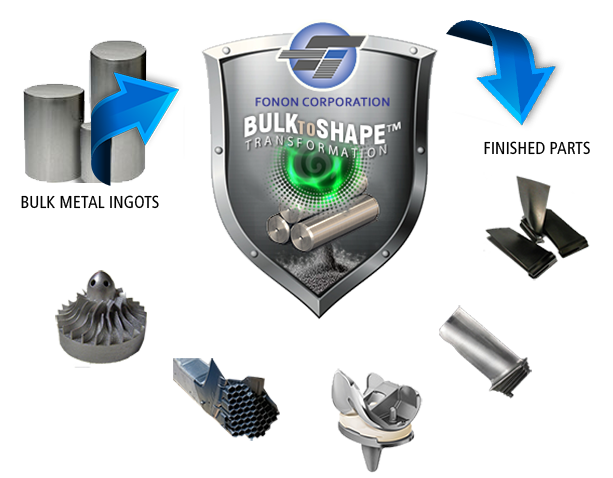Frequently asked questions

3D Metal Printing | 3D Fusion | Bulk-to-Shape 3D Applications | 3D Equipment Software
- Manufacturing Readiness Level (MRL)
- Bulk-To-Shape Transformational Technology (BTS)
- Recent comments by metal printing industry experts
- Multi-Kilowatt Fiber Laser
- LaserComb™ Technology
- Orthogonal to the Powder-Bed
- Direct Drive Motion System Technology
- Galvo
- Metal Processing Under Laser
- Metal Powder Formula
(MRL)-Manufacturing Readiness Level (MRL) is a measure system developed by the United States Department of Defense (DOD) to assess the maturity of their supplier’s manufacturing readiness. Manufacturers use this measurement system to determine the production readiness stage of new product development. The measurement system uses a scale from MRL1 to MRL10. As reported by many industry experts, today’s metal printing systems produce metal printed prototype parts ranging from MRL4-MRL6 for applications evaluated by the FDA with respect to passenger and patient safety. Metal printed parts are ready to move into production once manufacturing statistical data meets the requirements of MRL10.
(BTS)-Bulk-To-Shape Transformational Technology represents the company’s continuously expanding portfolio of building-block technologies driving metal printed parts to MLR10 manufacturing production readiness. Each system is designed for manufacturing purposes based on a common family of geometric shapes, part specification, and specific metal type. Fonon’s team of R&D scientists select the most suitable portfolio of options matched to the end-user’s metal application in terms of accuracy, body density, internal geometries, oxide content, product shape and dimensions. The final XYZ build plate architectural strategy is designed to support the end-user’s manufacturing mode in terms of object size, throughput rate and volume production requirement.
A Next-Generation Laser Optimized for Metal AM
The company uses a proprietary multi-kilowatt laser optimized for metal AM. The Flat-Top profile provides a predictable uniform illumination across the powder bed with a scalable beam-spot, no hot-spots or peripheral fall-off. With the use of a multi-kilowatt laser, processing speeds are increased when compared to 400W/500W Gaussian profile lasers used in current generation systems.
Scanning Strategy for Faster Metal Printing Speeds
The company’s proprietary LaserComb™ Beam Shaping Technology reduces manufacturing times and reduces unit-to-unit variations. Coupled with image splicing, LaserComb™ produces multiple laser beams at multiple wavelengths creating a plurality of scribe lines. The technology processes a much higher number of scanned lines/second over a larger area. The impeding beam is circular and constant in size & peak intensity across the scan with no pincushion distortions and accuracy better than 5μm.
Eliminating Reflectivity & Beam Spot Elongation
Incorporating both DDMS technology and the company’s proprietary LaserComb™ Beam Shaping Technology, the multi-kilowatt laser is orthogonal to the build-plate significantly reducing unit-to-unit metal printed part variations. The powder bed is presented with a predicable uniform illumination across the build-plate with an order of magnitude reduction in reflectivity with superior beam spot quality.
Current metal printing systems use a Galvo scan head for metal AM recognized as one of the key components that contributes to an unstable system process creating conditions for unpredictable variations in parts quality as the laser beam is constantly out of focus, with incalculable changes in reflectivity & energy density distribution, and continuous beam spot degradation.
Unlimited Build Plate Technology
Direct Drive Motion System (DDMS) technology is an automated platform that transports the multi-kilowatt laser across the build-plate expanding metal printing application sizes out to 1.5m x 3.0m. A low-friction magnetic based motion system, the laser levitates across the power bed orthogonal to the build plate significantly reducing wide unit-to-unit metal printed part variations associated with the use of a Galvo scan head. With advanced fully-sealed encoders, laser placement accuracies are within 5μm.
“The Galvo Scan Head was originally developed to draw patterns or images on walls for entertainment purposes and later adapted for fixed-position, laser-based subtractive material processing systems to deflect the laser beam across a larger surface area for the removal of metal. This technology is one of the greatest contributions to unit-to-unit variations with regards to metal AM.”

Quotes from Metal AM: Spring 2016 Edition
“Despite the outstanding promises of Metal Additive Manufacturing technologies, inconsistent quality, process reliability and speed are currently holding back industry growth and impacting on the cost-effectiveness of new applications”
“In terms of quality, AM for critical metal components such as those for aerospace and automotive still exhibits variability between runs, between machines, and over time.”
“Many manufacturers have openly stated that they see three basic limitations with parts made by metal AM;sconsitent quality, process reliability and part strength”
Quotes from Lawrence Livermore National Labs
“The production of metal parts via laser powder bed fusion additive manufacturing is growing exponentially. However, the transition of this technology from production of prototypes to production of critical parts is hindered by a lack of confidence in the quality of the part.”
“Metals produced suing AM have structure, properties, and performance that can differ from their cast and wrought counterparts. These include: density, residual stresses, mechanical behavior, non-equilibrium, microstructure, and crystallographic texture.
Scanning strategies can affect the properties of the part including density, mechanical properties and residual stress. Residual stress is one of several important material responses that need to be optimized for laser-based additive manufactured parts. A part can be fabricated within tolerances only to have residual stress-induced distortions put the part out of tolerance when removed from the build plate. Residual stress can also cause a part’s connection to support structures to fail.